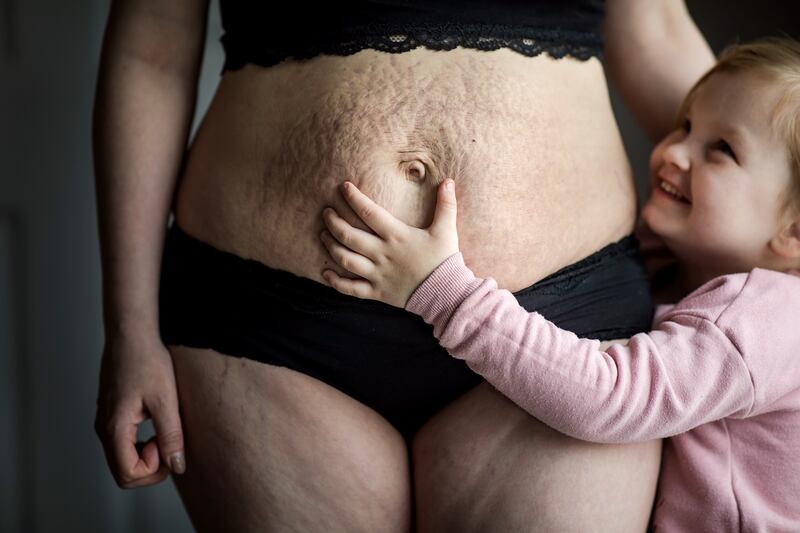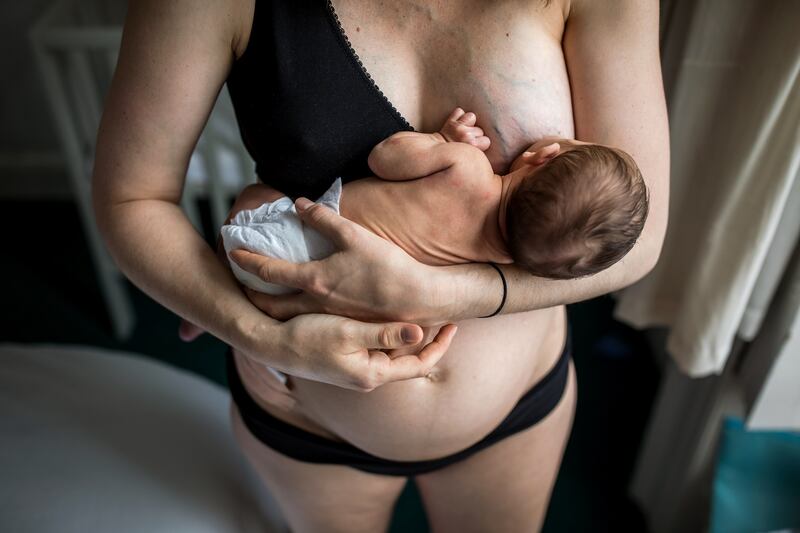A striking new photographic campaign, to be launched on December 1st (#storylines), aims to encourage more openness, acceptance and pride about what growing and birthing a new human does to a woman’s body.
It is the brainchild of Marian Kennedy, the founder of anewmum, an Irish start-up company that has been built on the back of her own experience of earning the stripes of motherhood. The birth of her first child was "fast and furious" and she was left with a grade three tear in her perineum.
“My waters broke about six o’clock in the evening, I got contractions at 11pm and she was born at one minute to 12,” she says of that momentous day when her baby daughter weighed in at a fairly hefty 4.2kg (9lb and 4oz) at the South Tipperary General Hospital in Clonmel. The stitching up afterwards, she recalls, was worse than the birth.

Back home, she struggled to recover and look after her newborn. She has always believed “if you’re not right physically, you’re not right mentally” but “I found it hard to take care of myself”.
Kennedy remembers dispatching her husband, Derek, to a pharmacy to find anything that might bring relief and promote healing. She wanted things that would be safe to use and not sting during the twice-daily showers she had been advised to take for the first six weeks to guard against infection.
An idle thought she had that it would be great if there was a range of healthcare products specifically for postpartum women like her slowly took root and began to grow. Four years and various entrepreneur programmes later, her own company is starting to produce exactly what she had wished for back then.
I don't think your body is ever the same
Before anewmum’s first products hit the shelves in March 2020, Marian is passionate about their forthcoming campaign to raise more awareness among new mothers – and their partners – about what to expect in the postpartum period.
Their website (anewmum.com) will be a forum for advice and sharing and is already offering a free birth plan guide.
“I noticed that women are embarrassed by their bodies,” she says. “New mums are expected to ‘snap back’ and it’s very hard because not everyone can.” In reality there is no going back, mentally or physically, once you have a child.
“I don’t think your body is ever the same,” says Marian. “Your body has done something amazing.”
Her collaborator in this celebration of the postpartum body is US photographer Neely Ker-Fox, for whom it's also a topic close to her heart. She barely recognised her body after the birth of her second child in 2014.
“My son was transverse breech, stretching horizontally across my belly from 26 weeks to 37 weeks. He was literally ripping my abdominal muscles apart as he grew, which in turn also gave me an umbilical hernia,” says Ker-Fox.
By six weeks postpartum she remained looking very much pregnant and years later “still strangers ask me when I’m due”. She struggled to accept, never mind like, her changed body.
“One day my son walked up, put his tiny hands on my squishy tummy. He jiggled it like a bowl full of jelly, with a giggle and a smile on his face. Then he gently kissed my herniated belly button, looked up with wide eyes, and told me he loved me. That was the day I started to love my body.”
We think of postpartum as the weeks to months after a baby is born, “the reality is, as mothers we are always postpartum”, she points out. “Our bodies irrevocably changed forever.”
While Ker-Fox was trying to cope with her own postpartum body issues in 2015, she did a photo project with more than 20 women called Perfect Imperfections, which went “wildly viral”.
150 women responded to a social media call-out
When Kennedy hired the Atlanta-based photographer to do something similar here, some 150 women responded to a social media call-out for postpartum volunteers. They were whittled down to eight for the two-day shoot.
“The photos capture everything I had hoped for and more,” says Kennedy, who found it “so positive and heart-warming” that these women were willing to participate to help change attitudes.
In the process of creating a business aimed at bringing healing and comfort to women’s nether regions, “the amount of men I have made red in the face is hilarious”, she laughs. On the other hand, she has also met complete strangers who, within minutes of hearing what she’s at, pour out tales of how many stitches they had or details of their re-infected Caesarean scars.
“Once you give them the topic, it’s out there; it’s okay to talk.” And it’s a conversation she hopes is about to get a whole lot louder.

‘I didn’t know how to dress’
“After my first pregnancy with my daughter, I felt like I had lost control of my body,” says Ali O’Leary, a mother of four from Tallaght who is one of the seven women photographed for the anewmum postpartum campaign.
“I didn’t know how to dress and constantly compared my postpartum body to my pre-baby one. It took me about a year to fully comprehend what my body had actually achieved.
“One day I stood in front of the mirror and told myself that the marks on my body were ‘Georgia’s first ever painting she did for me’. That was a game-changing perspective. Suddenly I saw my body as a trophy – a shiny, beautiful reminder of what it had given me!”
Then, after going on to have triplet boys, she says: “I may always have a C-section scar, a saggy belly and stretch marks. But I am so unbelievably proud of every line and what my body has done for me and my family.”
Kaitlin Eddy, who was photographed in Dublin one day after the birth by C-section of her son Stephen Hinson, sees her healing scar as “a badge of honour”.

She adds: “I am proud to wear this body and have my swollen, round tummy as a mark of where he grew safely for so long. I am proud of the stretch marks on my breasts that now fill with milk and allow me to feed my baby and give him everything he needs. I am glad that I will never return to my ‘pre-baby body’ and, though I hope to recover and regain my strength to continue exercising and moving how I want to, I will always bear the marks of carrying our boy and getting him here safely, and for that I am forever grateful.”
Taking time to build up strength
A woman's body is never quite the same after childbirth, agrees Niamh Kenny, a physiotherapist at the Rotunda Hospital in Dublin.
“If you’re looking at somebody’s abdomen or pelvic floor you can usually see the traces. There’s something that will tell you a baby has been through this system.”
Some people do recover extremely well, and you’d have to be somebody like her, “up close and personal”, to be able to tell, she says. For the majority of us, pregnancy and childbirth does leave a mark but that doesn’t mean you can’t be as strong and active as you ever were, she stresses.
However, that requires taking time to build up strength, doing it in the right order and getting help if and when you need it. She has worked with mothers who are employed as fitness instructors and “their abs look as if they have never had a baby but they’re leaking [urine] while they are taking a class”.
The pelvic floor and tummy muscles are the two muscle groups most affected by pregnancy and delivery, being “disproportionately weakened compared to the rest of your body,” she explains.
“If you overdo things, it can be at the expense of your core,” she warns. This may lead to pain in the back, pelvis or hips, the leaking of urine or faeces, or bring on a prolapse.

A new mother’s priority must be to rest, seeing the first six weeks as “a healing time” and not a “snapping back time”, she says. But physiotherapists encourage starting pelvic floor and abdominal exercises the day after birth and gentle walking when you’re able.
After six weeks, provided all is well, you should start slowly building up strength with low-impact exercise, such as cycling or swimming, but no running, jumping and lifting heavy weights until after three months. Pilates and yoga should also be left until then, unless the latter is a specific, gentle, post-natal class.
“It takes the guts of six to nine months to get your body to the level where you feel ‘I am as strong as I was before my baby’,” says Kenny.
What they don't realise is the potential harm they can do to their pelvic floor
While some women may be fearful about moving, or are totally focused on the baby and unaware of the benefits of exercise for themselves, others tend to do too much too soon. “What they don’t realise is the potential harm they can do to their pelvic floor.” Add to that the fact symptoms are not talked about and women may not know what is happening or where to go for help.
In the Rotunda there are weekly physiotherapy classes for women to attend over the first six weeks after delivering their babies there (eight weeks after a Caesarean) and they can self-refer for a physiotherapy appointment for up to six months (for pelvic floor issues). Most maternity hospitals have similar arrangements, Kenny adds, or there is the option of women’s physiotherapists in private practice.
She also recommends a guide to returning to running after pregnancy that is available online.


















